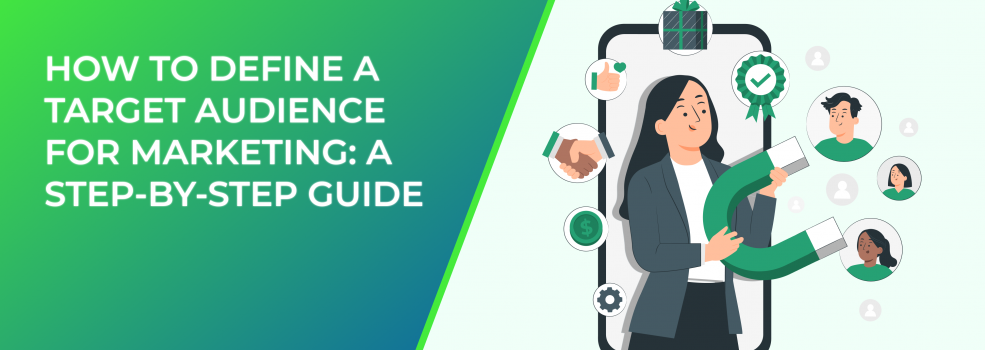Imagine pouring time and resources into your marketing efforts, only to find that your audience isn't engaging with your content, your ads are underperforming, and your sales are stagnant. It's a frustrating reality for many businesses, and one common factor is often at play: they’re speaking to the wrong people, or worse, they don’t know who they’re speaking to at all.
Identifying your target audience is a fundamental step in marketing. Without knowing who your ideal buyer persona is, you can’t develop products that meet their needs, create messaging that resonates with them, or choose the right platforms to reach them. Understanding your customers allows you to tailor every aspect of your business to serve those who are most likely to engage and convert.
In this guide, we’ll walk you through a step-by-step process to define and find your target audience. By the end, you’ll have a clear, actionable plan to ensure your marketing efforts are directed at the right people, resulting in higher engagement and better returns on your investment.

Step One: The importance of knowing your target audience
As mentioned, knowing your audience is the foundation of any successful marketing strategy. A well-defined audience allows you to focus your efforts, ensuring that your marketing budget and resources are used efficiently. Instead of casting a wide, ineffective net, you can speak directly to the people who are most likely to engage with your product or service. This precision impacts key business metrics:
- Higher ROI: Having answered the question “Who is your target market?”, you can craft messages that resonate more deeply, resulting in better conversions and, ultimately, a higher return on your investment.
- Marketing Efficiency: Targeting the right audience allows you to focus on specific platforms, content types, and messaging, reducing wasted time and effort.
- Customer Retention: Knowing your customers doesn’t stop at acquisition. When you understand their needs and preferences, you can continue providing value, increasing customer satisfaction and loyalty.
One of the biggest mistakes businesses make is trying to appeal to “everyone.” While it may seem like a smart move to reach as many people as possible, this approach often leads to generic and ineffective campaigns. Marketing to a broad, undefined audience dilutes your message and leaves you competing in an oversaturated market. As a result, you have:

- Weak Messaging: Instead of crafting tailored, compelling content, you end up creating vague messages that don’t resonate with anyone in particular.
- Wasted Resources: Without a clear target, you might invest in the wrong platforms or strategies, burning through your budget with little to show for it.
- Low Engagement: People are more likely to engage with brands that feel personal and relevant to them. A broad approach often leads to lower engagement rates and poor customer interaction.
Defining and understanding your audience lets you ensure that your marketing efforts are focused, effective, and built to foster long-term relationships.
Step Two: Start with your own product/service
Before you can find your target market, it’s essential to fully understand what you’re offering. Start by analyzing your product or service in detail. What are the key features that define it? What specific problems does it solve? Identify the core benefits that set your offering apart from others in the market — these are your unique selling points (USPs). Whether it's superior quality, a specialized feature, exceptional customer service, or a unique brand experience, your USPs will help determine who your ideal customer personas are and why they should choose you over a competitor.
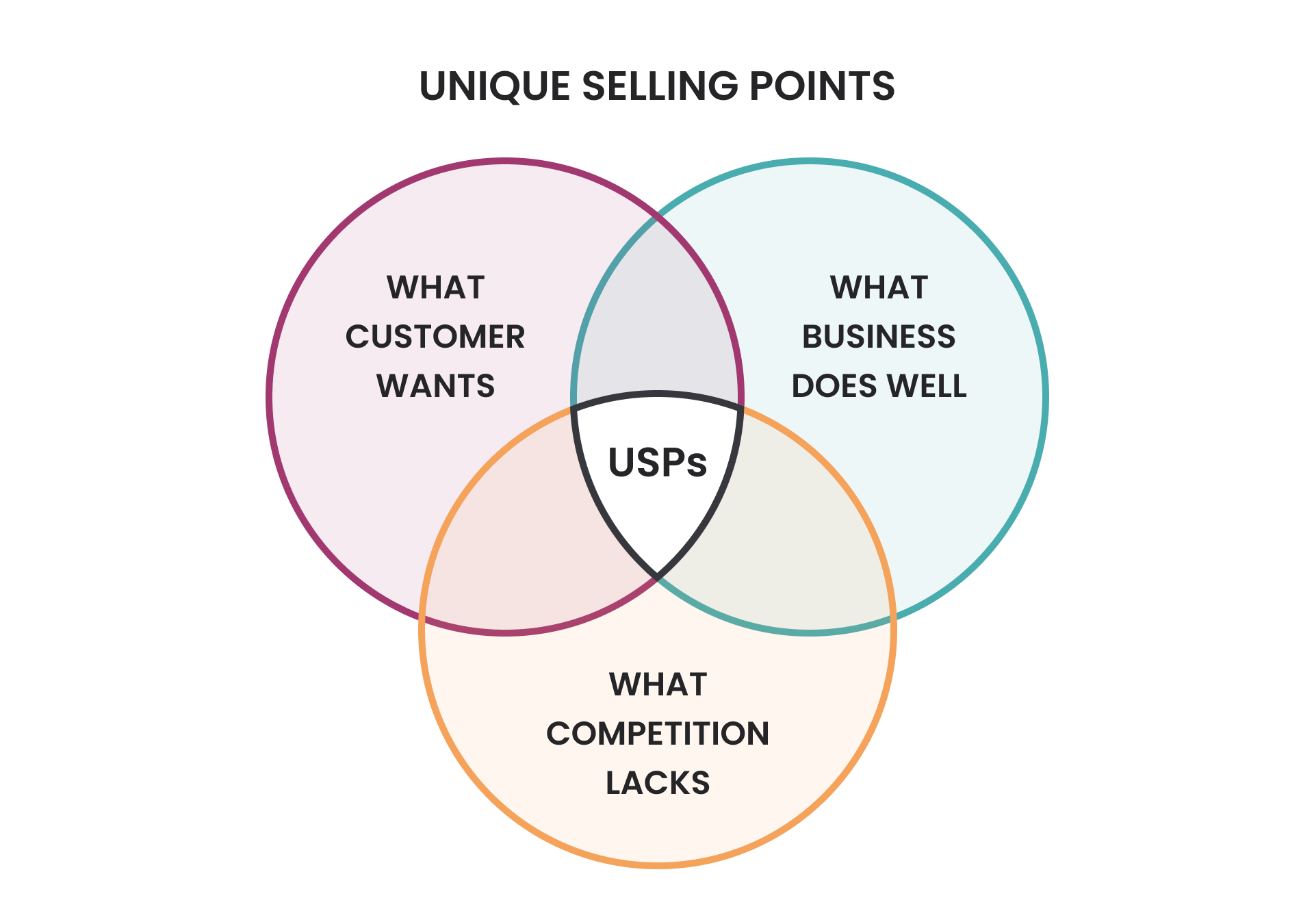
Once you’ve mapped out your product or service, the next step is to ask targeted questions that will help you realize how to define your target audience. By understanding who benefits most from your offering, you can begin to narrow down your potential customer base and refine your marketing strategies.
- Who Would Benefit Most?
Think about the people or businesses that would find your product most useful. What are their specific needs? For example, if you offer a premium fitness app, your target might be health-conscious individuals who prioritize convenience and high-quality training.
- Why Would Someone Choose Your Product?
Consider what differentiates your offering in the eyes of a potential customer. Is it the price? The features? The brand reputation? Understanding the "why" helps you determine what will drive your audience’s decision-making process and informs how you present your product in the marketplace.
Answering these questions creates a strong foundation to build upon when identifying and reaching the people who will value your product or service most.
Step Three: Conduct target market research
First, focus on primary research. It involves gathering firsthand information directly from your potential or existing customers. This type of research helps you uncover deeper insights into their needs, preferences, and pain points, allowing you to tailor your offering more effectively. There are several ways to collect this information:
- Surveys: Create questionnaires to gather insights on target market demographics, buying habits, preferences, and satisfaction levels. This can be done through email, social media, or directly on your website.
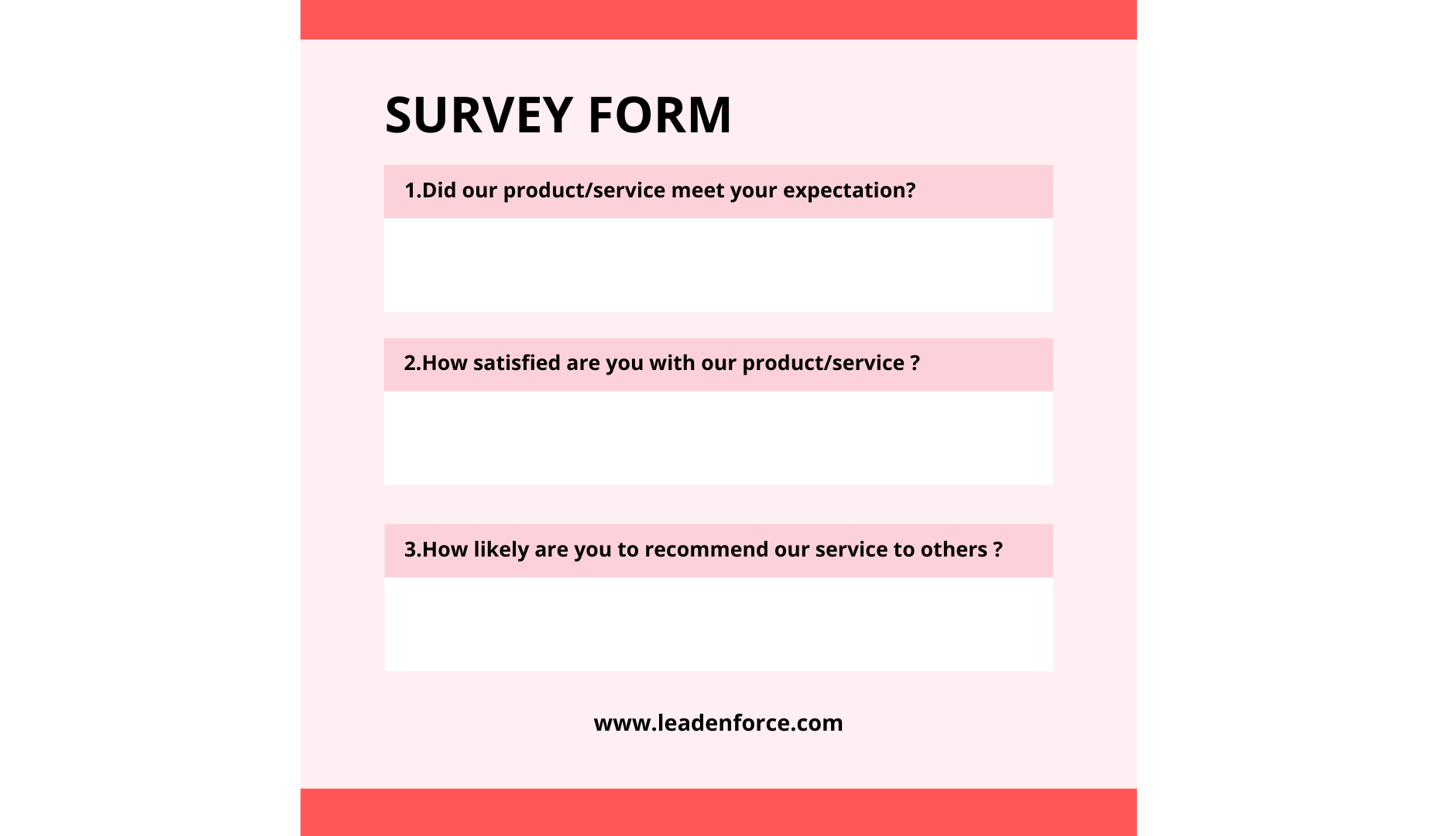
- Interviews: Speaking with customers one-on-one provides more detailed feedback. Interviews allow for open-ended responses, offering richer insights into why your product resonates — or doesn’t — with your audience.

- Customer Feedback: Analyzing feedback from customer support interactions, reviews, or testimonials can help identify patterns in what people value most or what they want improved.
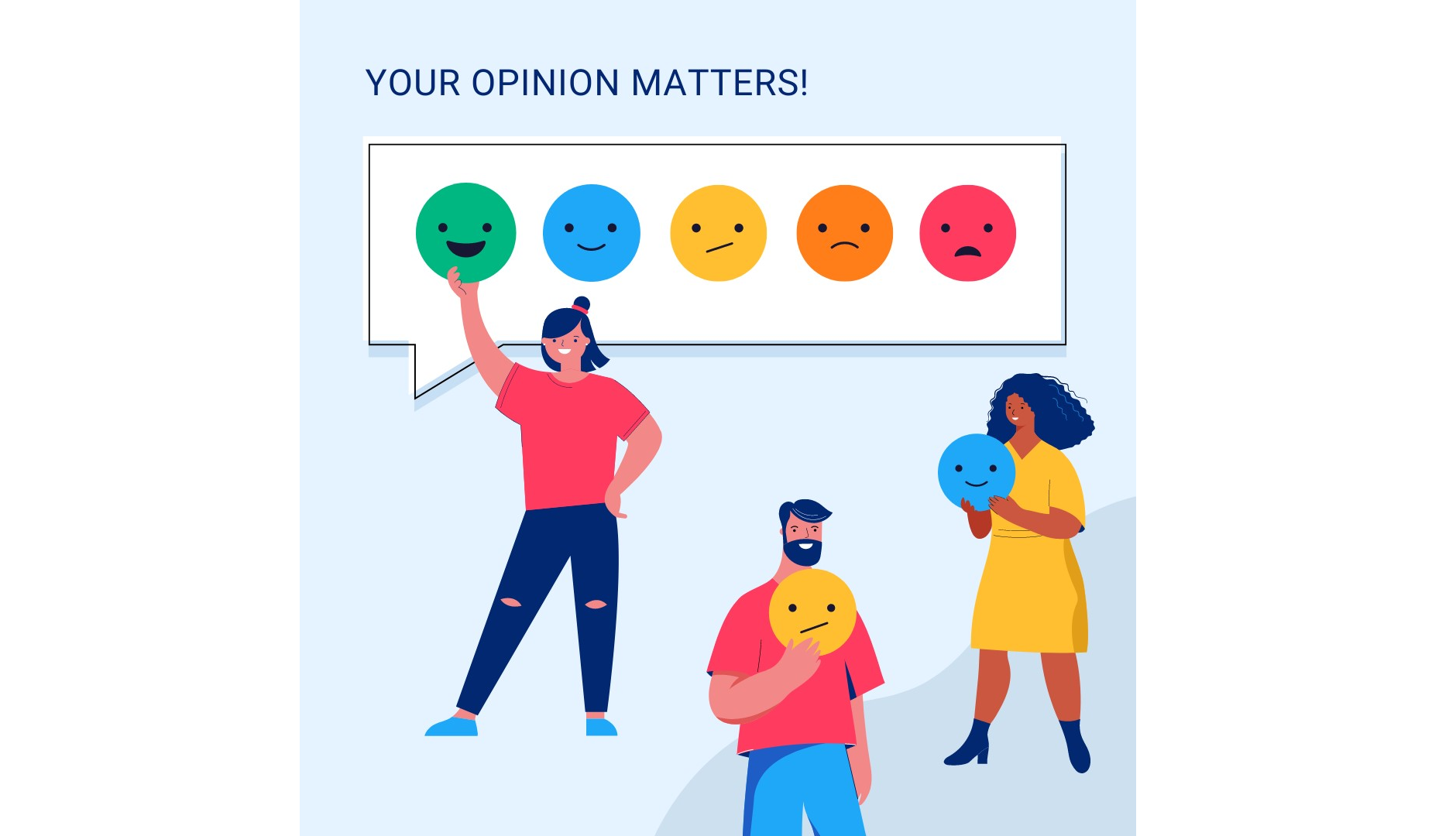
Leverage primary research to gain direct insights from your customers, that will allow you to refine your marketing strategy based on real-world responses.
Secondary research focuses on analyzing existing data and resources to better understand the market and your competitors. This helps you identify trends, gaps, and opportunities for growth. Sources of secondary research include:
- Competitor Analysis: Study your competitors to see how they position themselves, who they’re targeting, and what strategies they’re using. Look at their customer reviews to understand what they do well and where they fall short.
- Industry Reports: Industry publications, whitepapers, and trend reports offer valuable information on market conditions, emerging trends, and consumer behavior that may inform your strategy.
- Demographic Data: Use publicly available data from sources like government reports, academic studies, or industry associations to get a broad understanding of your potential audience based on factors like age, income, location, and buying patterns.
Secondary research provides context and benchmarks for your own business, helping you position yourself strategically within the market.
Data sources for market research
To complement your primary and secondary research, tap into data from digital platforms to uncover more about your audience's behaviors and preferences. These insights can help you refine your targeting and messaging with precision.
- Google Analytics: Analyze website traffic to learn about the demographics of your visitors, how they found you, and what pages or products they engage with most.

- Social Media Insights: Platforms like Facebook, Instagram, and LinkedIn provide detailed analytics about your followers, including their age, location, interests, and engagement habits. This data helps you understand which content resonates with your audience and which channels are most effective for reaching them.

- Other Data Sources: Use CRM systems, email marketing platforms, and other tools to track user behavior and preferences, such as open rates, click-through rates, or purchasing trends.
Combining these data-driven insights with your primary and secondary research gives you a comprehensive view of your target audience, allowing you to make informed decisions about your marketing strategy.
Step Four: Creating customer personas
Once you have gathered sufficient data, the next step is building a customer persona — a fictional representation of your ideal customer. These personas help you visualize and understand the characteristics of your target audience. Start with demographic information, which provides a foundational understanding of who your customers are:
- Age: Determine the age range of your target audience. Are they millennials, Gen Z, or baby boomers?
- Gender: Understand whether your product appeals more to a specific gender or if it’s gender-neutral.
- Location: Identify where your customers live — are they urban dwellers, suburban residents, or rural populations?
- Education: Consider the educational background of your audience. Are they college-educated, professionals, or working-class individuals?
- Income: Understand the income levels of your audience to tailor your pricing strategy and marketing messaging.
Demographics provide a surface-level understanding of your audience, but psychographics dive deeper into their motivations and behaviors. Consider the following aspects:
- Interests: What hobbies or activities does your target audience engage in? Understanding their interests can guide your content creation and marketing strategies.
- Values: What principles matter to them? Values such as sustainability, health, or community involvement can significantly influence purchasing decisions.
- Lifestyle: Analyze the lifestyle choices of your audience. Are they busy professionals, stay-at-home parents, or fitness enthusiasts? This can affect how and when they interact with your brand.
- Purchasing behavior: Look at how they shop. Are they price-sensitive, brand-loyal, or influenced by trends? This insight helps you tailor your offers and communication.
With demographic and psychographic data in hand, it’s time to create 2-3 detailed audience personas. Each persona should encapsulate the key characteristics of a segment of your target audience. Here’s an example of how to structure each persona:
Persona 1: Health-Conscious Millennial
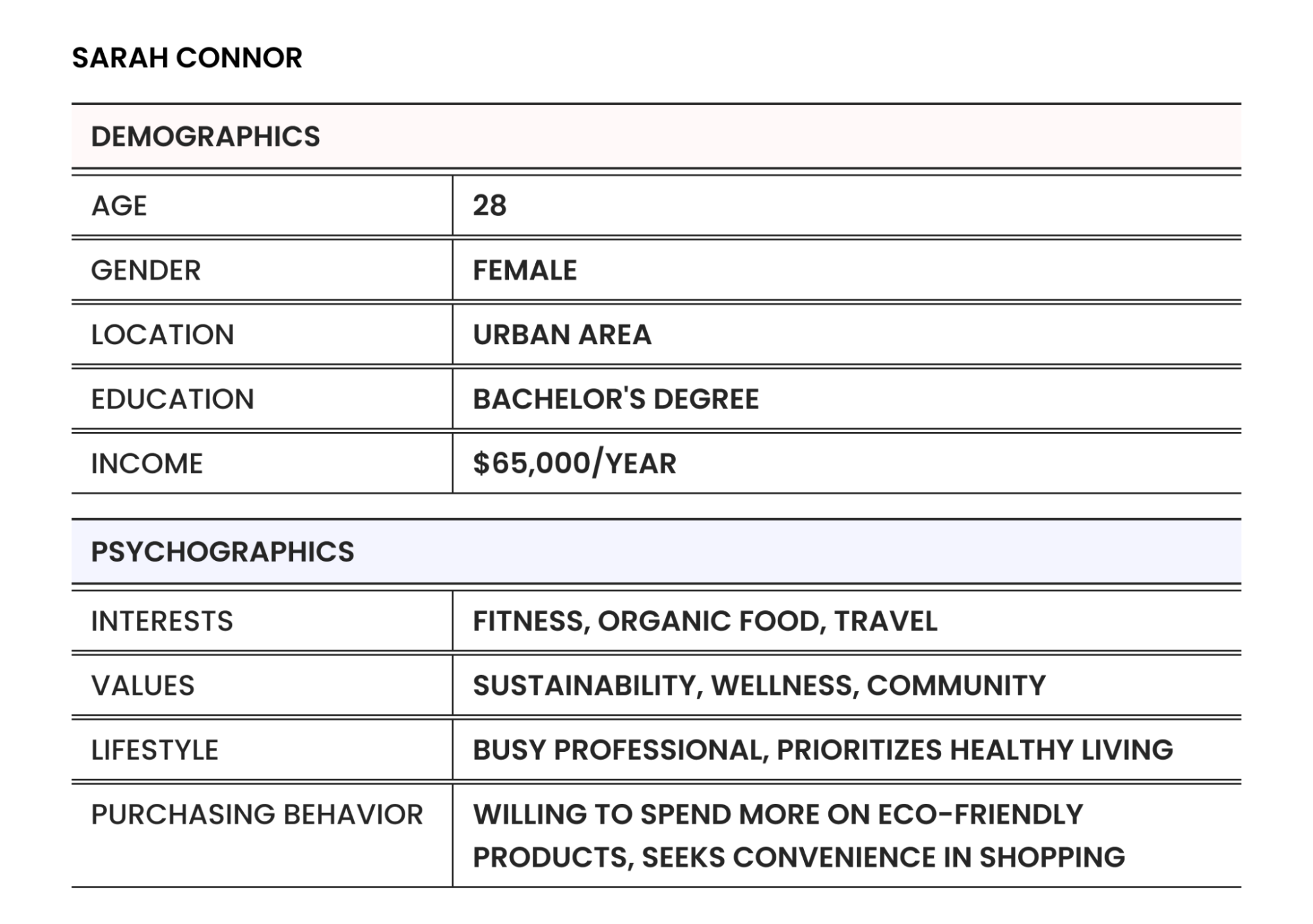
Persona 2: Budget-Conscious Parent
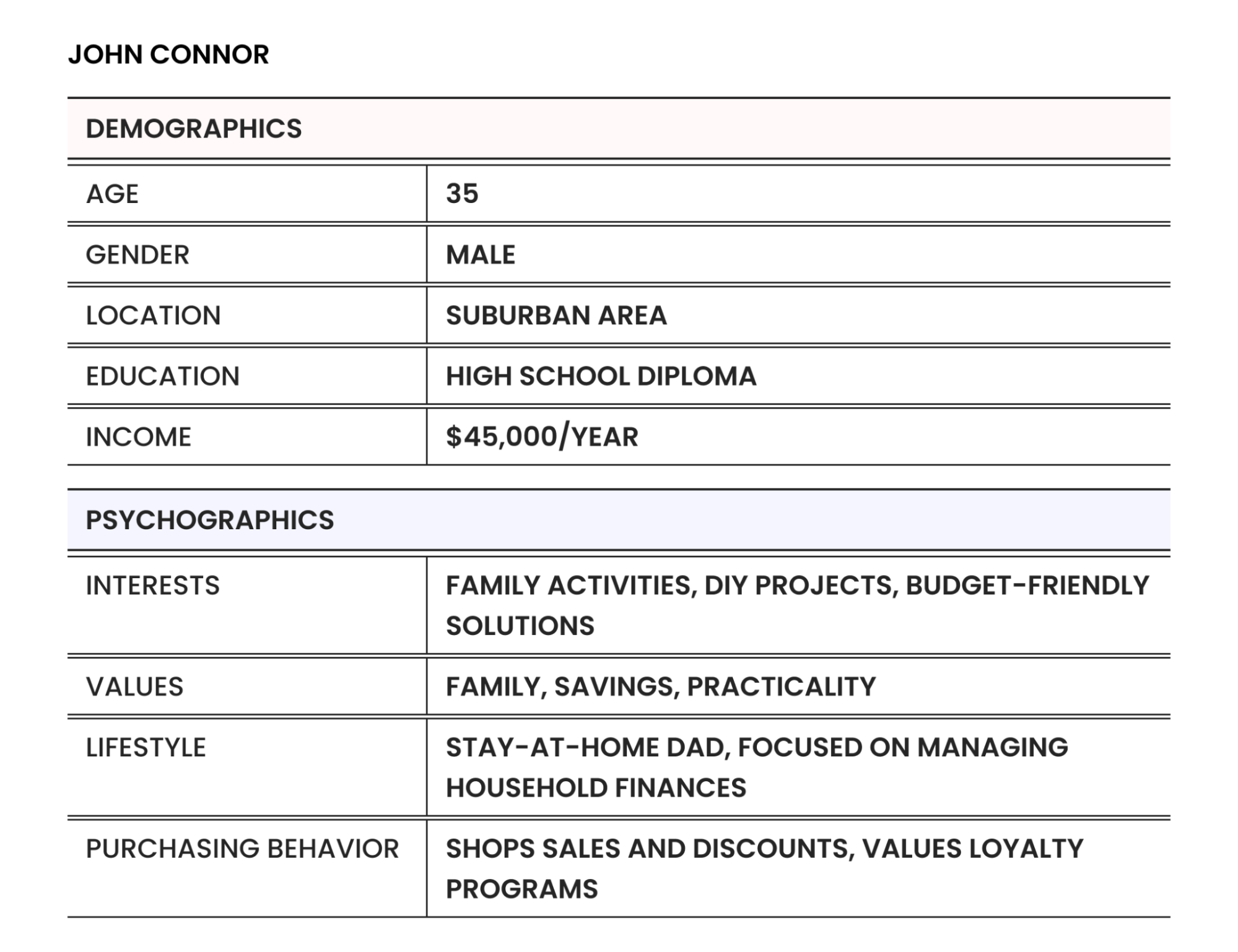
Practical Tip
To help you get started, here’s a simple template for creating your audience personas:
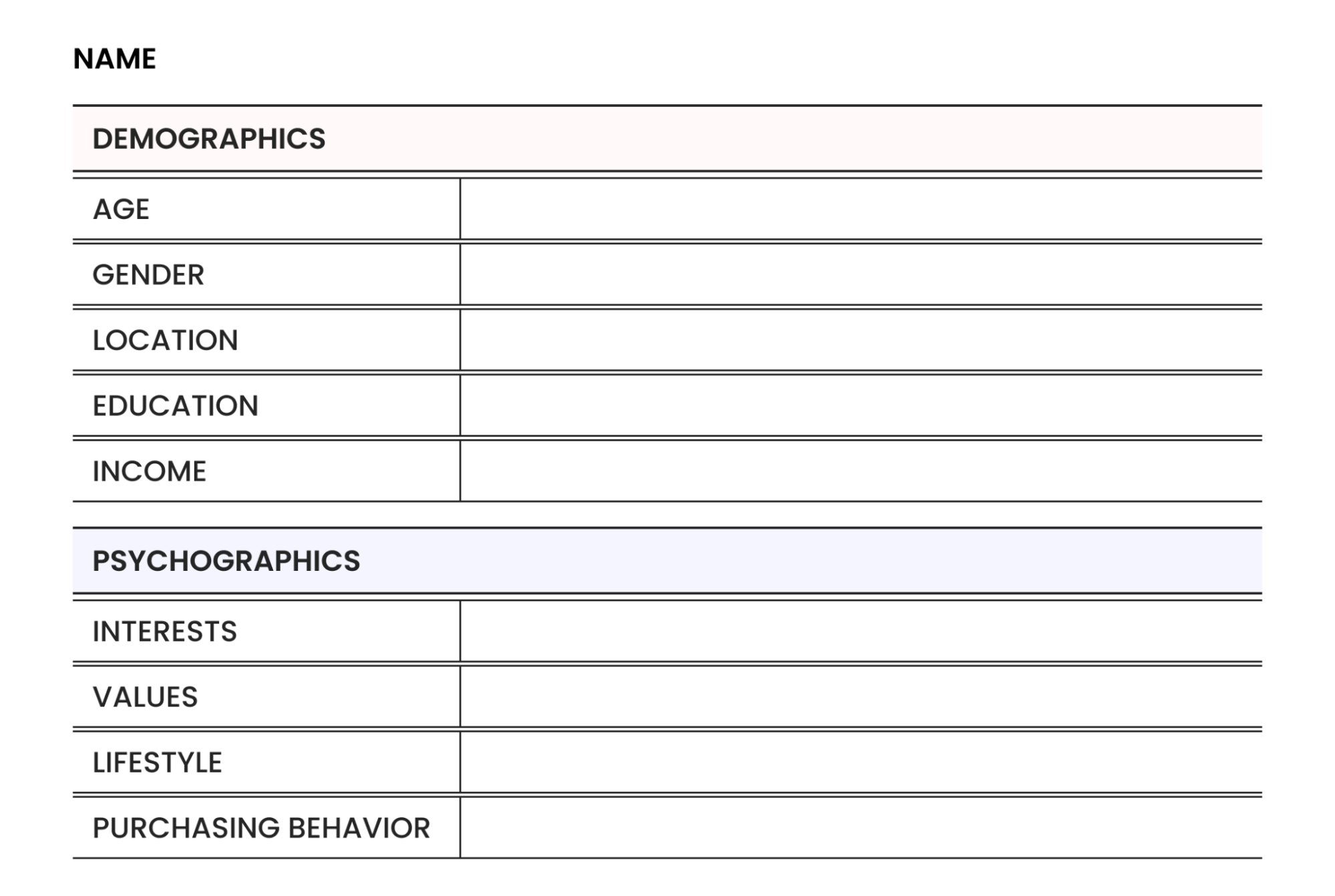
Using this template, you can develop comprehensive buyer personas that guide your marketing strategies, ensuring that your messaging resonates with the right people. These personas will serve as a constant reminder of who you’re marketing to, helping you stay focused and relevant in your efforts.
Step Five: Identify where your target audience spends time
Once you have a clear understanding of your audience personas, the next step is to identify where your audience spends their time online. This insight is crucial for crafting an effective marketing strategy that targets the right platforms.
- Social Media Platforms: Determine which social media platforms your audience prefers. Are they active on Facebook, Instagram, TikTok, LinkedIn, or Twitter? Each platform attracts different demographics and user behaviors, so understanding where your audience engages will guide your social media marketing efforts.
- Websites and Forums: Identify the websites, blogs, or online forums that your audience frequents. Are they visiting niche forums related to their interests, engaging with industry-specific blogs, or participating in community discussions? Knowing these platforms helps you strategize guest posts, partnerships, or advertising opportunities.
- Online Communities: Look for online communities, such as Facebook groups, Reddit threads, or specialized forums where your audience interacts. Engaging in these spaces can help you gain insights into their needs and preferences while building brand awareness.
Content Preferences
Understanding the types of content your audience prefers is essential for tailoring your messaging and marketing strategies.
- Engagement Styles: Analyze how your audience engages with content. Are they more likely to read blogs, watch videos, listen to podcasts, or scroll through social media posts? Each format has its own strengths and can be leveraged differently in your marketing approach.
- Content Types: Identify which types of content resonate most with your audience. For example, if they prefer visual content, focus on infographics or videos. If they value in-depth analysis, create comprehensive articles or whitepapers. Knowing what type of content drives engagement allows you to create and share materials that capture their attention.
Communication Channels
Finally, understanding how your audience prefers to be reached is crucial for effective communication and marketing. Different audience segments may have distinct preferences when it comes to communication channels. Think about the following:
- Social Media
- In-App Messaging
- Other Channels
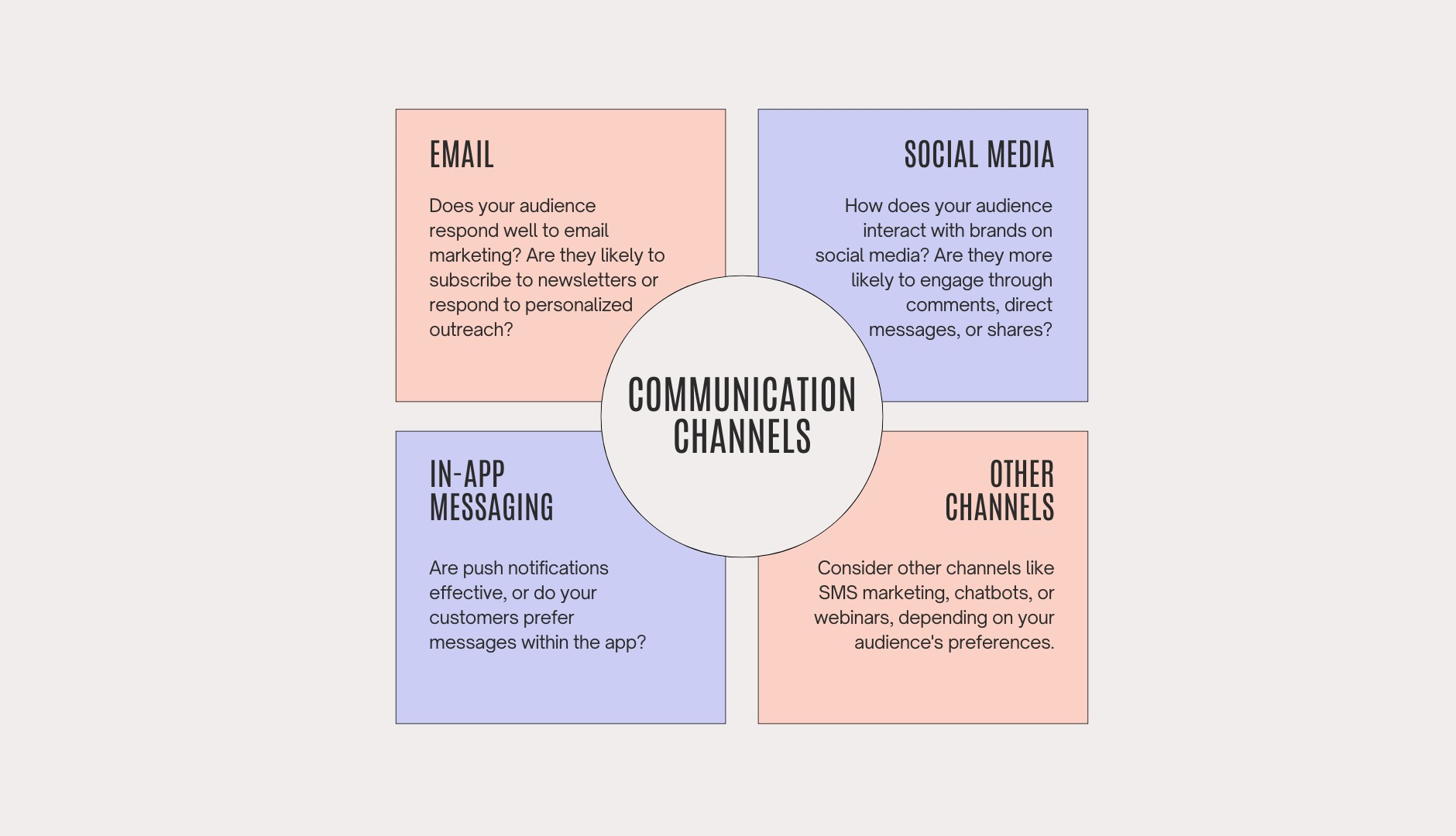
By identifying where your audience spends their time, the content they prefer, and their favored communication channels, you can strategically position your marketing efforts to maximize impact and engagement. This knowledge ensures your message reaches the right people in the right place, increasing the likelihood of building meaningful connections and driving conversions.
Step Six: Segment and test your audience
After creating target audience personas and gathering insights about their behaviors and preferences, the next steps are segmentation, testing, and adjusting them.

Segmentation
The segmentation process involves dividing your larger audience into smaller, more manageable groups based on specific characteristics. Segmentation allows you to tailor your marketing strategies to meet the unique needs of each group, ultimately increasing engagement and conversions.
So, how to categorize target audiences? Well, pay attention to the following:
- Behaviors: Analyze how different segments interact with your brand. Are they first-time visitors, repeat customers, or inactive users? Understanding their behaviors helps you create targeted campaigns that cater to their specific needs.
- Needs: Identify the varying needs of different segments. For instance, some customers may prioritize price, while others focus on quality or brand values. Tailoring your messaging to address these distinct needs can enhance relevance and appeal.
- Stages of the Buyer’s Journey: Segment your audience based on their position in the buyer’s journey — awareness, consideration, or decision. Each stage requires different messaging and content to guide them toward making a purchase.
By segmenting your audience, you can create personalized marketing strategies that resonate more deeply with each group, leading to higher engagement and conversion rates.
A/B Testing
With your audience segmented, it’s time to experiment with A/B testing. A/B testing involves comparing two or more versions of a marketing element to see which one performs better. This testing can be applied to various aspects of your marketing strategy:
- Messages: Test different headlines, CTAs, or content styles to determine which resonates with your audience more. For instance, you might try different value propositions in your email subject lines to see which drives higher open rates.
- Platforms: Experiment with different social media platforms or advertising channels to find out where your audience is most responsive. You may discover that certain demographics engage more on Instagram while others prefer LinkedIn.
- Content types: Analyze which types of content perform best. For example, test whether videos, infographics, or written content yield higher engagement rates among your audience segments.
By conducting A/B tests, you can gather data-driven insights that inform your marketing decisions and help optimize your strategies.
Adjust Based on Feedback
The insights gained from segmentation and A/B testing provide invaluable feedback for refining your audience and marketing strategies. Here's how to effectively use this feedback:
- Analyze results: Carefully examine the outcomes of your tests. Identify which messages, platforms, or content types performed best and why. Look for trends and patterns in engagement metrics, such as click-through rates, conversion rates, and overall audience interaction.
- Refine your strategies: Use the insights from your target audience analysis to adjust your marketing approach. This may involve updating your messaging, reallocating your advertising budget to higher-performing channels, or creating more of the content types that resonate with your audience.
- Improve continuously: Audience preferences and behaviors can evolve over time, so it’s essential to continuously test, learn, and adapt. Make A/B testing a regular part of your marketing strategy to ensure you stay in tune with your audience's changing needs and preferences.
Segmenting your audience, experimenting with A/B testing, and refining your strategies based on feedback helps you create a more effective marketing plan that speaks directly to your customers’ needs and drives meaningful engagement. This iterative approach not only enhances your marketing efforts but also builds stronger relationships with your audience over time.
Step Seven: Refine over time
Audience preferences and behaviors are not static; they tend to evolve. This ongoing change necessitates a commitment to continuous learning and assessment. Regularly reassessing your target audience allows you to stay relevant and responsive to their needs. Here’s how to facilitate this process:
- Scheduled reviews: Set up regular intervals (e.g., quarterly or biannually) to review your audience insights and buyer personas. This can help you identify shifts in preferences, interests, or demographics that may impact your marketing approach.
- Stay informed: Keep abreast of industry trends, emerging technologies, and changes in consumer behavior. Subscribe to relevant newsletters, attend webinars, or participate in industry conferences to stay updated on the latest developments.
- Engagement monitoring: Continuously track engagement metrics across your marketing channels. Monitor social media interactions, website traffic, and customer feedback to spot patterns that indicate changing preferences.
Being adaptable is crucial in marketing. As you gather new data and insights, be prepared to pivot your strategies accordingly.

- Use the insights you gather from ongoing research and audience monitoring to change your marketing strategies. If certain segments are showing increased engagement, consider allocating more resources to target them further.
- Don’t be afraid to try new approaches based on the latest trends or audience feedback. This could mean testing different content formats, exploring new platforms, or refining your messaging to better resonate with your audience.
- Establish a feedback loop with your audience. Encourage them to share their thoughts on your products, services, and content. Use surveys, polls, or direct communication to gather their insights, and be sure to implement changes based on their input.
- Embrace an agile marketing approach that allows for flexibility and rapid responses to changes in the market or audience preferences. This can involve quick iterations of campaigns or strategies to adapt to new findings.
By committing to continuous learning and being ready to adapt your strategies, you’ll ensure that your marketing efforts remain effective and aligned with your audience’s evolving needs. This ongoing refinement process not only strengthens your brand's relevance but also fosters deeper connections with your customers, ultimately driving long-term success.
Conclusion
Finding your target audience is a crucial process that involves several key steps, all aimed at making your marketing efforts more focused and effective.
First, it begins with a deep understanding of your product or service, identifying the unique features and benefits that differentiate you from competitors.
Next, conducting both primary and secondary market research helps gather insights about your potential audience and their behaviors.
Afterward, creating personas for marketing helps you visualize and define who your ideal customers are.
Finally, it's essential to refine your approach over time, continuously learning from new data and adapting your strategies based on evolving audience preferences.
Now that you have a clear, actionable framework for finding and defining your target audience, it's time to put it into practice. Start by analyzing your current audience — are they the right fit for your product or service? If you're not sure, dive into market research to gain the insights you need. Take that first step today, and begin building a more focused, data-driven marketing strategy that will resonate with the right people and drive meaningful results.
